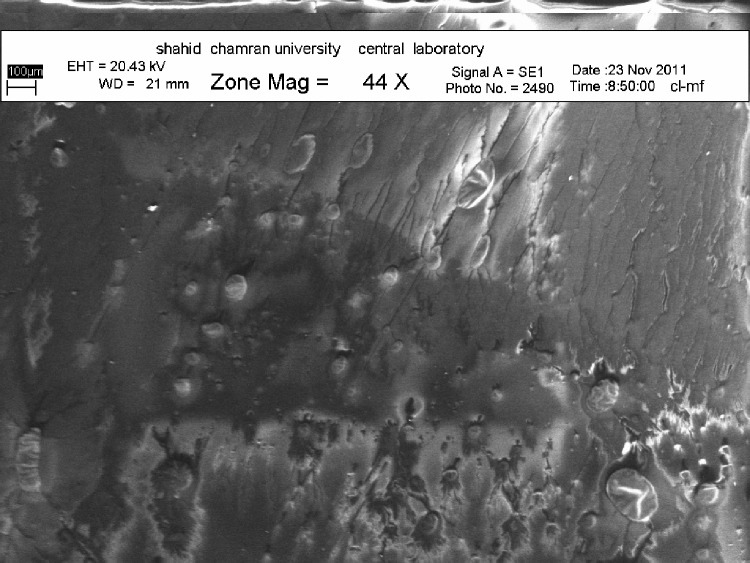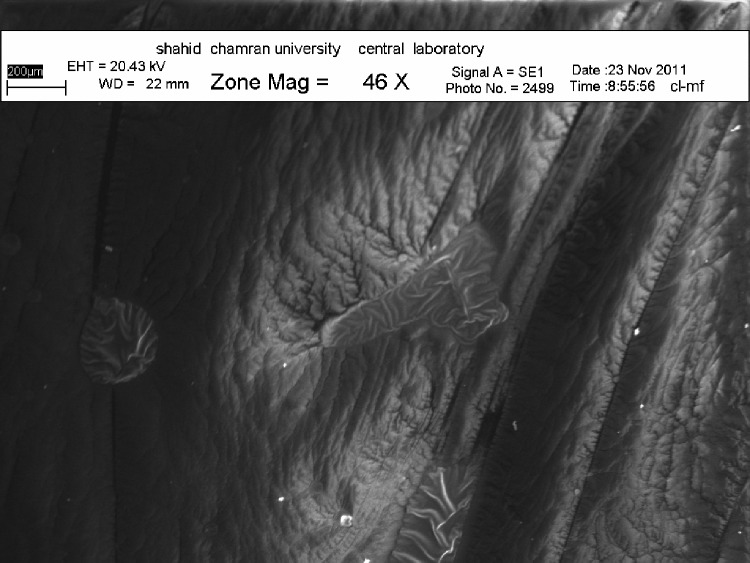Abstract
Purpose: The aim of the present research was to formulate a transparent microemolsion as a topical delivery system for tretinoin for the treatment of acne. Methods: Microemulsion formulations prepared by mixing appropriate amount of surfactant including Tween 80 and Labrasol, co-surfactant such as propylene glycol (PG) and oil phase including isopropyl myristate – transcutol P (10:1 ratio). The prepared microemolsions were evaluated regarding their particle size, zeta potential, conductivity, stability, viscosity, differential scanning calorimetry (DSC), scanning electron microscopy (SEM), refractory index (RI) and pH. Results: The results showed that maximum oil was incorporated in microemolsion system that was contained surfactant to co-surfactant ratio (Km) of 4:1. The mean droplets size range of microemulsion formulation were in the range of 14.1 to 36.5 nm and its refractory index (RI) and pH were 1.46 and 6.1, respectively. Viscosity range was 200-350 cps. Drug release profile showed 49% of the drug released in the first 8 hours of experiment belong to ME-7. Also, Hexagonal and cubic structures were seen in the SEM photograph of the microemulsions. Conclusion: physicochemical properties and in vitro release were dependent upon the contents of S/C, water and, oil percentage in formulations.Also, ME-7 may be preferable for topical tretinoin formulation.
Keywords: Tretinoin, Phase diagram, Microemulsion, Differential scanning calorimetry
Introduction
The word microemulsion was originally proposed by Hoar and Schulman in the earliest of the 1940s. They were generated a clear single-phase solution by titrating a milky emulsion with hexanol.1 Microemulsions are thermodynamically stable, isotropic clear colloidal dispersion of oil, water and surfactant, frequently in combination with a co-surfactant which have high stability, ultra low interfacial tension, large interface area , low viscosity and ease of preparation.2,3 Conventional microemulsions can be classified oil- in -water, (o/w), water- -in- oil (w/o) and bicontinuous phase microemulsions. Some advantages offered by microemulsions include improvement in poorly drug solubility, enhancement of bioavailability, protection of the unstable drugs against environmental conditions and a long shelf life.
Tretinoin is trans-retinoic acid and related to retinol (vitamin A). The drug in use decreases proliferation of acute promyelocytic leukemia APL cells in culture and in vivo. The drug is used for treatment of various skin disorders including acne, photo aged skin and severe condition like psoriasis, squamous cell carcinoma.4,5 The main aim of our investigation was to develop and evaluate a microemulsion based tretinoin (0.05%, w/w) for topical delivery. The proposed tretinoin concentration is chosen on the basis of the marketed tretinoin formulations. The ability of microemulsion to improve photostability of tretinoin was also investigated in the present study.
Materials and Methods
Tretinoin was purchased from Sepidaj Company (Iran). Isopropyl myristate, Tween 80 and PG were obtained from Merck (Germany), Caprylocaproyl macrogoglycerides (Labrasol) and Diethylene glycol monoethyle ether (Transcutol P) were gift from Gattefosse Company (France). All chemicals and solvents were of analytical grade. Freshly distilled water was used in the experiments. Minitab15 software was used for experimental design and the evaluation of the effect of variables on responses. Sigma plot software was applied for providing tertiary phase diagrams.
Tretinoin assay
The quantitative determination of tretinoin was performed by UV spectrophotometry (BioWaveII,WPA) at λmax = 362 nm.
Solubility of tretinoin
Solubility of tretinoin was determined in different oil (oleic acid, isopropyl myristate, transcutol P), surfactants (Span 80, Labrasol, Tween 80) and co-surfactant (Propylen glycol) by dissolving an excess amount of tretinoin in 3ml of oil, and other components using a stirrer at 37 oC ± 0.5 for 72 h.6 The equilibrated samples were then centrifuged at 10000rpm for 30 min to remove the undissolved drug. The solubility of tretinoin was determined by analyzing the filtrate spectrophotometrically using nanospecterophotometry (Biochrom WPA Bioware) after dilution with methanol at 362 nm.
Pseudo-ternary phase diagram construction
To investigate concentration range of components for the existing boundary of MEs, pseudo-ternary phase diagrams were constructed using the water titration method. Three phase diagrams were prepared with the 2:1, 3:1, and 4:1 weight ratios of (Labrasol /Tween 80) Propylen glycol respectively. Oil phase (Oleic acid-Transcutol P) and the surfactant mixture were then mixed at the weight ratios of 1:9, 2:8, 3:7, 4:6, 5:5, 6:4, 7:3, 8:2, and 9:1.7 These mixtures were diluted dropwise with double distilled water, under moderate agitation. The samples were classified as microemulsions when they appeared as clear liquids.8
Several parameters influence on final properties of microemulsions. Full factorial design was used concerning with 3 variables at 2 levels for formulations Major variables take part in determination of microemulsion’s properties includes surfactant/cosurfactant ratio (S/C), percentage of oil (% oil) and water percentage (%w). Eight different formulations with low and high values of oil (5% and 30%), water (5%, 15%), and S/Co mixing ratio (3:1, 4:1) were prepared for preparing of microemulsion formulation.
Preparation of tretinoin microemulsions
Various MEs were selected from the pseudoternary phase diagram with 3:1, and 4:1 weight ratio of Labrasol /Tween 80/Propylen glycol. Tretinoin(0.05%) was added to oil phase , then adding S/ CoS mixture and an appropriate amount of double distilled water was added to the mixture drop by drop and the MEs containing tretinoin were obtained by stirring the mixtures at ambient temperature.9,10
Differential scanning calorimetry (DSC)
DSC measurements were carried out by means of a Metller Toldo DSC1 starR system equipped with refrigerated cooling system (Hubert Tc45). Approximately 10-15mg of microemulsion samples were weighted into hermetic aluminium pans and quickly sealed to prevent water evaporation from microemulsion samples. Simultaneously an empty hermetically sealed pan was used as a reference. Microemulsion samples were exposed in a temperature ranging from +30 0C to - 50 0C (scan rate: 100C/min).
In order to ensure accuracy and repeatability of data, DSC instrument was calibrated and checked under the conditions of use by indium standard. Changes of Enthalpy quantities (∆H) were calculated from endothermic and exothermic transitions of thermograms by Eq1:10-12
∆H= peak area/sample weight
Scanning electron microscopy (SEM)
Scanning electron microscopy (SEM) was used to characterize microstructure of emulsions. SEM of samples were measured by LED 1455VP, Germany.
Zeta potential determination
Zeta potential of samples were measured by Zetasizer (Malvern instrument 1td ZEN3600, UK). Samples were placed in clear disposable zeta cells and results were recorded. Before putting the fresh sample, cuvettes were washed with methanol and rinsed using the sample to be measured before each experiment.
Particle size measurements
The average droplet size of samples was measured at 25 °C by SCATTER SCOPE 1 QUIDIX (South Korea) and their refractory indices were also calculated.
Determination of viscosity
The viscosity microemulsions were measured at 25 °C with a Brookfield viscometer (DV-II+Pro Brookfield., USA) using spindle no. 34. With shear rate 100 rpm.13
Conductivity measurements
The electric conductivity of ME was measured with a conductivity meter (Metrohm Model 712). This was done by using conductivity cell (with a cell constant of 1.0) consisting of two platinum plates separated by desired distance and having liquid between the platinum plate acting as a conductor.
Determination of pH
The pH values for microemolsion was determined at 25°C by pH meter (Mettler Toledo seven easy, Switzerland). All measurements were carried out in triplicate.
Surface tension measurement
The surface tension of microemulsion was measured at 25°C with a Torsion balance (WHITE ELEC Model NO. 83944E).
Stability study
The stability of microemulsions was studied regarding the temperature stability and centrifugation. Microemulsions were kept in various temperature ranges (4 °C, 25 °C and 37 °C) and observed for phase separation, flocculation or precipitation. Also, Microemulsions were centrifuged by high speed brushless centrifuge (MPV-350R, Poland at 10000 rpm for 30 minute at 25 °C and inspected for any change in their homogeneity.
Release study
Franz diffusion cells (area 3.4618 cm2) with a cellulose membrane were utilized to determine the Release rate of tretinoin from different microemulsion formulations. The cellulose (molecular weight G12 000) membrane was first hydrated in the distilled water solution at 25 0C for 24 hours. The membrane was then clamped between the donor and receptor compartments of the cells Diffusion cell was filled with 25 ml of phosphate buffer (pH = 7.4) and methanol (1:2). The receptor fluid was constantly stirred by externally driven magnetic bars at 600 rpm throughout the experiment. Tretinoin microemulsion (5 g) was accurately weighted and placed in donor compartment. At 0.5, 1, 2, 3, 4, 5, 6, 7, 8 and 24 h time intervals, 2 ml sample was removed from receptor for spectrophotometric determination and replaced immediately with an equal volume of fresh receptor solution. Samples were analyzed by UV visible spectrophotometer (BioWaveII,WPA) at 362 nm. The results were plotted as cumulative released drug percent versus time.
Statistical methods
All the experiments were repeated three times and data were expressed as the mean value ± SD. Statistical data were analyzed by one-way analysis of variance (ANOVA) and P < 0.05 was considered to be significant with 95% confidence intervals.
Results and discussion
The maximum solubility of tretinoin was found in Isopropyl mirystate: Transcotol P (10:1) (4.85 ± 0.09) as compared to other oils (Table 1). In addition, the highest drug solubility of tretinoin in surfactants were found in Labrasol (3.232 ± 0.23), and Tween 80 (4.27 ± 0.12). Based on the solubility studies of tretinoin in oil, surfactant and co-surfactant and the preformulation studies we found IPM-Transcutol P, labrasol, Tween 80 and propylene glycol could be the most appropriate combination for preparation of microemulsion.
Table 1. Solubility of Tretinoin in different oils, surfactant and co-surfactant (mean ± SD, n = 3) .
| Phase type | Excipient | Solubility (mg/ml) |
| oil | Oleic acid | 3.61± 0.3 |
| Isopropyl Myristat | 1.32 ± 0.091 | |
| Oleic acid + Transcutol P | 3.69 ± 0.046 | |
| Isopropy Myristat +Transcutol P | 4.85 ±0.09 | |
| surfactant | Tween 80 | 4.27 ± 0.12 |
| Span 80 | 2.494 ± 0.03 | |
| labrasol | 3.232 ± 0.23 | |
| co-surfactant | Propylene glycol | 7.93 ± 0.06 |
Pseudo-ternary phase diagrams of the investigated quaternary system water/ isopropyl mirystate, Transcotol P (10:1)/ Labrasole -Tween 80/ PG is showed in figure 1. Microemulsions were formed at ambient temperature. The phase diagrams clearly indicated that microemulsion existence region increased with increase in the weight ratio of surfactant/cosurfactant (km=2 - 4).
Figure 1. The pseudo-ternary phase diagrams of the oil-surfactant/cosurfactant mixture–water system at the 2:1, 3:1, and 4:1 weight ratio of labrasol /Tween 80/ Propylene glycol at ambient temperature, dark area show microemulsions zone.
Km=3.
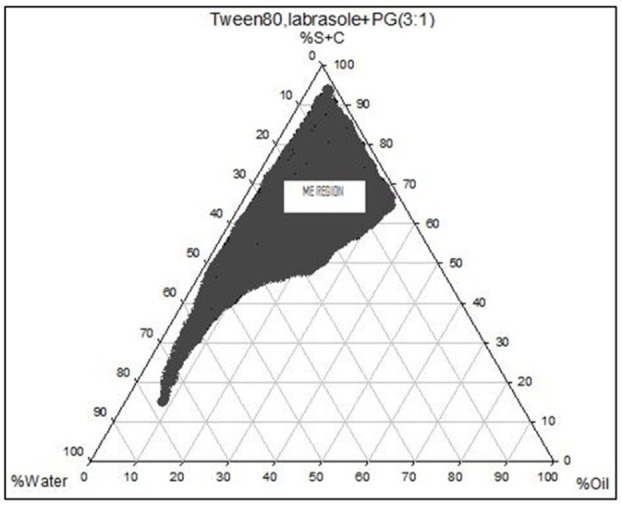
Km=2.
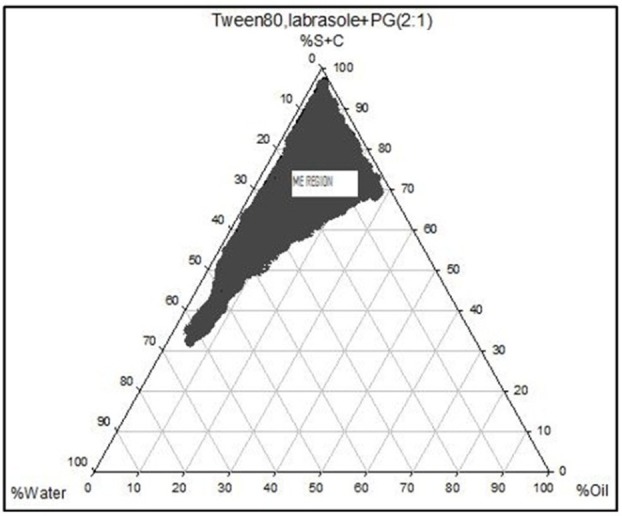
Km=4.
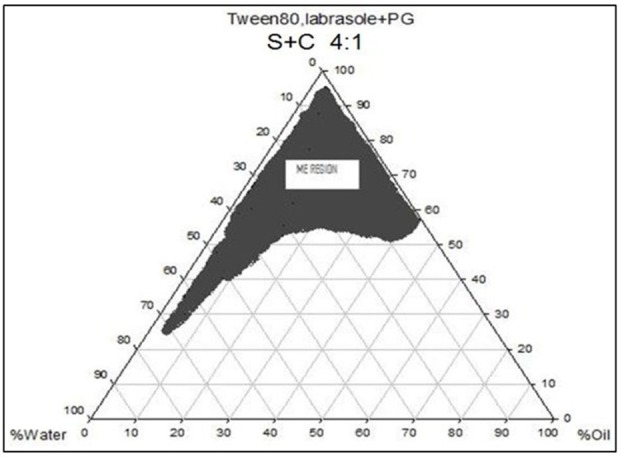
The ME formulations had the mean particle size in the range of 14-60 nm (Table 2). Particle size of selected ME and drug loaded ME were determined and there was no significant difference observed in average particle size after loading the drug. The ME 6 formulation had the lowest average particle size 14.1 ± 0.6 nm with polydispersity index (PI) of 0.362 ± 0.010 (Table 2). PI is a measure of particle homogeneity and it varies from 0.0 to 1.0. The closer to zero the PI value the more homogenous are the particles.
Table 2. Compositions of Selected Microemulsions (% w/w) and Particle Size (mean ± SD, n=3) .
| Formulation | Factorial | S/C | Oil | S+C | water | Particle size(nm) | Polydispersity |
| ME-1 | + + + | 4:1 | 30 | 55 | 15 | 15.3±0.5 | 0.362±0.032 |
| ME-2 | + + - | 4:1 | 30 | 65 | 5 | 53.9±1.3 | 0.411±0.015 |
| ME-3 | + - + | 4:1 | 5 | 80 | 15 | 20.8±0.8 | 0.372±0.024 |
| ME-4 | + - - | 4:1 | 5 | 90 | 5 | 31.7±1.05 | 0.352±0.016 |
| ME-5 | - - - | 3:1 | 5 | 90 | 5 | 17.3±0.4 | 0.361±0.027 |
| ME-6 | - - + | 3:1 | 5 | 80 | 15 | 14.1±0.6 | 0.362±0.010 |
| ME-7 | - + - | 3:1 | 30 | 65 | 5 | 59.3±1.7 | 0.393±0.031 |
| ME-8 | - + + | 3:1 | 30 | 55 | 15 | 36.5±1.2 | 0.381±0.022 |
+: high level; - : low level
The PI indicated that ME formulation had narrow size distribution. Analysis of variance is shown that correlation between mean particle size, PI and independent variables are not significant (p > 0.05).
The refractive index (RI) of the ME formulation was found 1.45 that is near to oil phase which indicates MEs formulations have water -in-oil structures. Analysis of variance is shown that correlation between RI and independent variables (%w) are significant (p < 0.05). Linear equation which indicates all the main effects for RI is: RI=1.45 + 0.0012s/c-0.000124 (%oil)-0.000625 (%water).
The ME formulations had the average conductivity in the range of 0.0447-0.0900 ms/cm.
The ME formulation had appropriate observed pH value (6.84 ± 0.11) that is best for topical application. Incorporation of tretinoin did not significantly affect the observed pH value of the ME formulations (Table 3).
Table 3. pH, Refractive index,Conductivity and Zeta potential of selected Tretinoin microemulsions (mean ± SD, n = 3) .
| Formulation | pH | Refractive index | Zeta potential(mv) |
conductivity (ms/cm) |
| ME-1 | 6.1±0.15 | 1.4412±0.002 | -2.30 | 0.0662±0.0011 |
| ME-2 | 6.83±0.08 | 1.4450±0.008 | -1.88 | 0.0593±0.0002 |
| ME-3 | 6.72±0.1 | 1.4413±0.012 | -2.19 | 0.0900±0.0012 |
| ME-4 | 6.76±0.14 | 1.4505±0.003 | -2.27 | 0.0634±0.0003 |
| ME-5 | 6.87±0.18 | 1.4491±0.012 | -3.45 | 0.0535±0.0008 |
| ME-6 | 6.73±0.16 | 1.4409±0.009 | -6.41 | 0.0447±0.0017 |
| ME-7 | 6.84±0.11 | 1.4435±0.016 | -3.24 | 0.0495±0.0009 |
| ME-8 | 6.87±0.13 | 1.4397±0.019 | -0.0674 | 0.00902±0.0015 |
The ME formulation had the average viscosity range (215.5 ± 5.2cps - 343.5 ± 8.3cps) (Table 4). The highest viscosity belongs to ME-8 formulation with bicontinueous structure. Multivariate regression was applied for the analysis of correlation between independent variables and MEs viscosity. The percent of water and s/c had more positive effect and negative effect on viscosity, respectively.
Table 4. Surface tension and viscosity of selected microemulsions (mean ± SD, n=3).
| Formulation | Surface tension (dyne/cm) | Viscosity(cps) |
| ME-1 | 37.83±1.25 | 215.5±5.2 |
| ME-2 | 38.16±1.04 | 228.4±6.3 |
| ME-3 | 38.83±1.25 | 290.1±7.1 |
| ME-4 | 37.83±1.25 | 226.2±7.8 |
| ME-5 | 40±2.17 | 253.4±3.7 |
| ME-6 | 39.66±0.76 | 271.3±5.8 |
| ME-7 | 39.66±1.52 | 229.4±4.8 |
| ME-8 | 38.16±1.04 | 343.5±8.3 |
Linear equation which shows all the main effects for viscosity is: Viscosity = 336-34.3s/c-0.24 (%oil) + 4.57(%water). There was no significant difference found between the viscosities of free drug and drug loaded MEs (p > 0.05).
The ME formulation had the zeta potential average (-0.0674-6.41mv) (Table 3). The highest zeta potential belongs to ME-6 formulation with micellar and bicontiuous structure the lowest belong to ME-8 with bicontinuous structure. Multivariate regression was used for the analysis of correlation between independent variables and MEs zeta potential. The S/C had more positive effect on zeta potential. There was no significant difference found between the zeta potential and independent variables (p > 0.05).
The MEs formulation had the surface tension average (37.83 ± 1.25 to 40 ± 2.17 dyne/cm) (Table 4).The surface tension data implies water –in-oil microemulsions because surface tension amounts of MEs is nearby to oil phase surface tension.
Figure 2 shows the release profiles of microemulsions of tretinoin MEs formulations. The cumulative amount of tretinoin that had permeated through the cellulose membrane (%) was plotted as a function of time (hours). In this study, ME-7 and ME-8 have the highest and lowest accumulative release percent, respectively. It was observed that there is a strong correlation between the water percent, S/C ratio and release percentage value of tretinoin (p < 0.05). Multivariate regression was used for the analysis of correlation between independent variables and MEs release. The percent of water and S/C ratio had more negative accumulative release percent, respectively. Linear equation which shows all the main effects for accumulative release percent is: %Release = 39.9-2.75S/C + 0.0206 (%oil) - 0.349(%water).
Figure 2.

In vitro release profile of MEs formulation of tretinoin.
Figure 3 shows the SEM images of ME-7 and ME-8.
Figure 3. SEM photographs of of ME-7 and ME-8.
ME-7.
ME-8.
DSC result implies important information about water state in microemulsions.15 When water is mixed in to a microemulsion system it can be either bound (interfacial) or free (bulk) water depending of its state in the system. In cooling curves of the samples (ME1-ME2), DSC thermogram showed one exothermic peak at around -10 to -14 0C that indicate the freezing of internal or bound water in these formulations. The other exothermic peak at around – 19 to – 25 0C belong to oil phase freezing.14,15 In cooling curves of ME-3 and ME-4 , DSC thermograms showed one exothermic peak at -330C (ME-3) and two exothermic peak at -1 and -34.40C for ME -4 which indicates bulk water(-10 C) and bound water (-33, -34.4 0C). DSC thermograms of ME-5 and ME-6 showed two exothermic peak at -20C (bulk water) and 39.8-40.9 0C (bound water. science the freezing temperature is very low, the water must be strongly bound or interacts with surfactants.16 In cooling curves of ME-7 and ME-8, DSC thermogrms showed two exothermic peaks of around -9 to -15 0C and -22 to -24 0C, which indicates bound water and oil phase freezing, respectively. Figure 4 shows DSC cooling thermogram of ME-8 and ME-7 formulations. Pure oil peaks could be observed at -14 and -28 0C, and became smaller when the water concentration in creased. The peaks disappeared at 15% wt/wt water, suggesting that oil phase changed from external to internal phase.
Figure 4. DSC cooling thermograms of ME-7(A) and ME-8(B)formulations.
A.
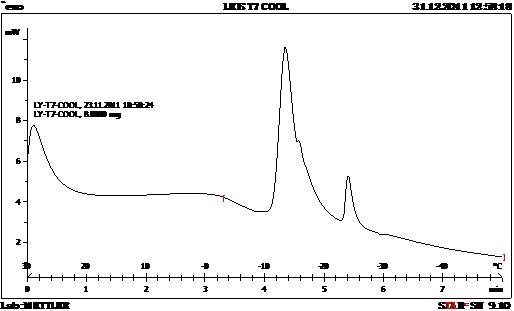
B.
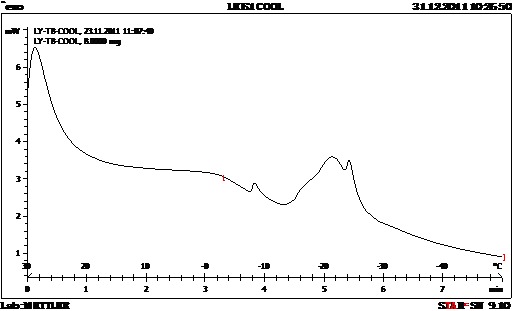
The visual inspection test was performed for 3 months by drawing ME sample at weekly interval for the first month and monthly interval for the subsequent months. The visual observation showed no evidence of phase separation or any flocculation or precipitation.
These samples also revealed no sign of phase separation under stress when subjected to centrifugation at 10000 rpm for 30 min. The centrifugtion tests revealed that microemulsions were remained homogenous without any phase separation throughout the test indicates good physical stability of both preparations.
Conclusion
This study demonstrated that physicochemical properties and in vitro release were dependent upon the contents of S/C, water and, oil percentage in formulations. Phase diagrams indicated more width microemulsion region with a rise in S/C ratio. It seems that the effect of PG as co-surfactant in MEs release profile may be as retardant, since with decrease in S/C ratio and water and increase in oil phase ratio could be obtained high in vitro percentage release. ME-7 may be preferable for topical tretinoin formulation, however, significant work still needs to be carried out to elucidate the mechanisms of drug delivery into the skin.
Acknowledgement
This paper is extracted from pharm.D.thesis (Leis, F) and financial support was provided by Ahvaz Jundishapur University of Medical Sciences. The authors are very thankful to Faratin company Executive manager (Taheri, M, Iran) for providing gratis samples of Labrasol and Transcutol P from GATTEFOSSE (France) and also GATTEFOSSE company (France).
Conflict of Interest
There is no conflict of interest in this study.
References
- 1.Fialho SL, Silva-Cunha AD. New vehicle based on a microemulsion for topical ocular administration of dexamethasone. Clin Experiment Ophthalmol. 2004;32:626–32. doi: 10.1111/j.1442-9071.2004.00914.x. [DOI] [PubMed] [Google Scholar]
- 2.Kreilgaard M. Dermal pharmacokinetics of microemulsions determined by in vivo microdialysis. Pharm Res. 2001;18:367–73. doi: 10.1023/a:1011067300397. [DOI] [PubMed] [Google Scholar]
- 3.Kreilgaard M. Influence of microemulsions on cutaneous drug delivery. Adv Drug Deliv Rev. 2002;54:S77–98. doi: 10.1016/s0169-409x(02)00116-3. [DOI] [PubMed] [Google Scholar]
- 4.Cohen BA, Prose N, Schachner LA. Acne. In: Schachner LA, Hansen RC, editors. Pediatric Dermatology. New York: Churchill Livingstone; 1988. pp. 663-94.
- 5.Suthar M, Modi D, Patel P, Baria H. Microemulsion-Based gel formulation and evaluation of tretinoin for topical delivery. Int J Pharm Res. 2009;1(4):28–34. [Google Scholar]
- 6.Sanjula B, Faiyaz S, Alka A, Javed A, Sheikh S. Design, development and evaluation of novel nanoemulsion formulation for transdermal potential of celecoxib. Acta Pharm. 2007;57:315–32. doi: 10.2478/v10007-007-0025-5. [DOI] [PubMed] [Google Scholar]
- 7.Wilk KA, Zielinska K, Hamerska-Dudra A, Jezierski A. Biocompatible microemulsions of dicephalic aldonamide-type surfactants: Formulation, structure and temperature influence. J Colloid Interface Sci. 2009;334:87–95. doi: 10.1016/j.jcis.2009.03.071. [DOI] [PubMed] [Google Scholar]
- 8.Sharif Makhmal zadeh B, Moghimi H. Formulation of microemulsion system for improvement of nitrofurazone permeation through silicon membrane as burn wound imitating coverage. Int J Pharmacol. 2010;6(3):264–70. [Google Scholar]
- 9.Shafiq S, Faiyaz S, Sushma T, Farhan J, Khar R, Ali M. Development and bioavailability assessment of ramipril nanoemulsion formulation: In vitro and in vivo assessment. J Biomed Nanotechnol. 2007;2:28–44. doi: 10.1016/j.ejpb.2006.10.014. [DOI] [PubMed] [Google Scholar]
- 10.Sharif Makhmal zadeh B, Torabi SH. Optimization of ibuprofen delivery through rat skin from traditional and novel nanoemulsion formulations. Iran J Pharm Res. 2012;11(1):47–58. [PMC free article] [PubMed] [Google Scholar]
- 11.Sharif Makhmal zadeh BS, Hasani MH. The effect of chemical and physical enhancers on trolamine salicylate permeation through rat skin. Trop J pharm Res. 2010;9(6):541–8. [Google Scholar]
- 12.Gabbot P. Principles and applications of thermal analysis. Australia: Blackwell Publishing; 2008. 2-49 [Google Scholar]
- 13.Lapasin R, Grassi M, Coceani N. Effects of polymer addition on the rheology of o/w microemulsions. Rheol Acta. 2001;40:185–92. [Google Scholar]
- 14.Garti N, Aserin A, Tiunova I, Fanum M. A DSC study of water behavior in w/o microemulsions stabilized by sucrose esters and butanol. Colloid Surface. 2000;120:1–18. [Google Scholar]
- 15.Podlogar F, Gasperlin M, Tomsic M, Jamnik A, Rogac MB. Structural characterisation of water-tween 40/imwitor 308-isopropyl myristate microemulsions using different experimental methods. Int J Pharm. 2004;276:115–28. doi: 10.1016/j.ijpharm.2004.02.018. [DOI] [PubMed] [Google Scholar]
- 16.Zhang J, Michniak-kohn B. Investigation of microemulsion microstructures and their relationship to transdermal permeation of model drugs: ketoprofen, lidocaine and caffeine. Int J Pharm. 2011;421:34–44. doi: 10.1016/j.ijpharm.2011.09.014. [DOI] [PubMed] [Google Scholar]



